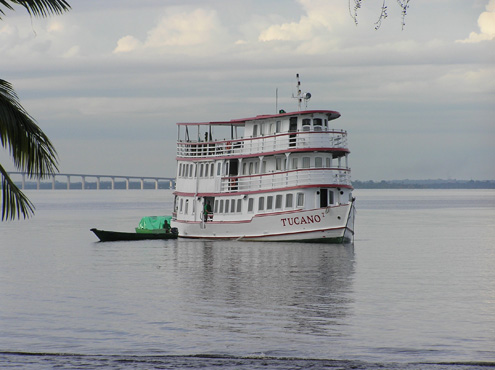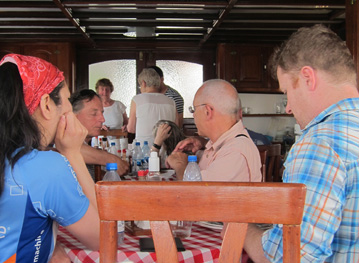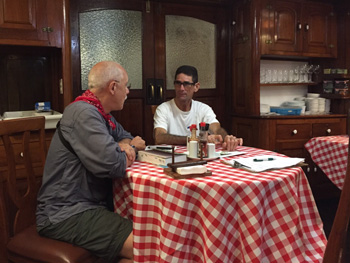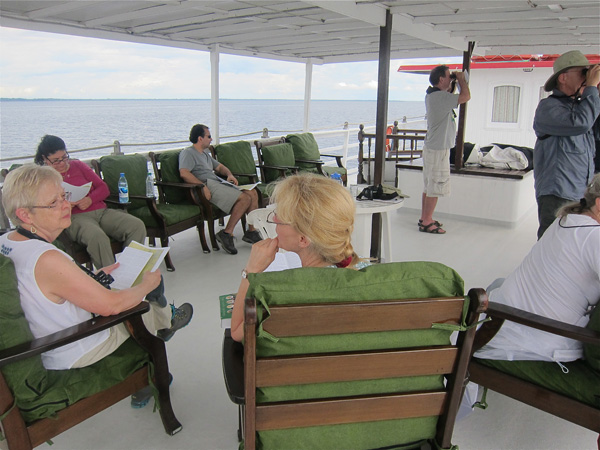Motor Yacht Tucano
A Day in the life | Settlers | Hermit | Tapioca/Cassava | Meeting of Waters | Lists | Manaus | M/Y Tucano | Ecology | Maps
AdventureSmith has the best (and most detailed) account of the riverboat that I have found, and I have stolen long extracts from it here, embellished with our own pictures and my occasional commentary. Given the typical calmness of the Rio Negro, Tucano is able to have three decks accommodating large cabins, full-size bathrooms and many comforts that would simply not be possible in a contemporary design. Besides, the Tucano’s traditional riverboat appearance is a definite part of her charm. The rest of the Tucano's charm is unquestionably provided by her crew. A more friendly, unassuming, professional, and accommodating bunch you couldn't hope to meet. They felt like a family, and they made us feel like family too. The Lists page introduces the crew and guests individually. The cabins, salon and main corridors are crafted of varnished wood accented by polished brass hardware and the walls are decorated with framed botanical prints and antique maps. Especially important is that the riverboat style allows the M/Y Tucano to have many large windows— over 70 of them, all of which are three feet high and every cabin has at least four view windows, which makes the vessel bright and airy. |
|
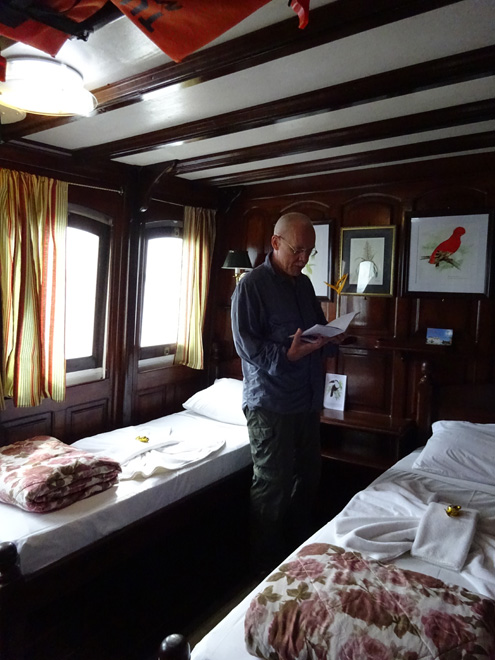 Each of the Tucanos’s nine comfortable cabins is air conditioned (most of the time), private bath with a hot water pressurized shower, toilet and sink. Most cabins have individual beds and some have above and below beds.
Each of the Tucanos’s nine comfortable cabins is air conditioned (most of the time), private bath with a hot water pressurized shower, toilet and sink. Most cabins have individual beds and some have above and below beds.
Our cabin is on the main deck, a blessing for me because it is the most stable, but in fact the river is flat as a pancake the vast majority of the time, and I had zero problem with motion-sickness. At the stern, the main deck also houses the crew’s quarters and galley and between the cabins and crew section, the main entry allows access to the canoes and kayaks that are always used for expeditions.
The balcony around the front of the boat on the middle deck is not used much (you might as well be upstairs on the observation deck) but the doors out onto it make the salon feel more roomy, and some of us used them to make it easier to move between the forward table and the server, rather than squeezing passed the other tables. The salon is airy and has windows all the way around. It is a wonderful place to relax with a good book, and/or sip a glass of wine or a beer, especially when the AC is running.
Those of us trying to keep detailed logs debriefed with the human guides often found here, and with the (illustrated) guides and reference books always found here. Edi also kept a running total of all sorts of things on a white board outside the salon.
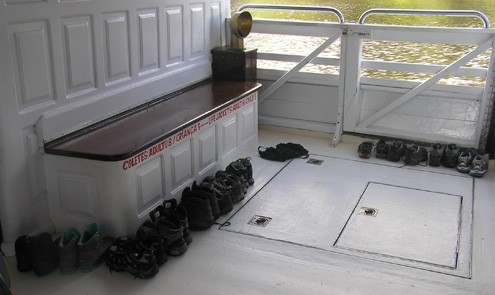
Image courtesy and © Lucy Mueller 2015
Since he only had his memory, and I tried to note down everything as we came across it, I enjoyed a little routine Edi and I got into after dinner, comparing notes at the whiteboard.
In addition to this simply being an interesting detail, the boots shot above is a great example of the "nothing is too much trouble" service the crew provided. We were forbidden to wear our muddy boots on board after returning from the terra firma trips. So everybody shed their boots as they came aboard. An hour later the now spotless boots were back lovingly paired up in these neat rows.
|
Of course the main purpose of the salon is as a dining room. Meals aboard Tucano are not gourmet but nor would we expect them to be. Rather the cook makes the very best out of the wonderful fruits, fishes and flavors unique to the Amazon. Meals are wholesome, filling and delicious. Manioc is always available, along with tea and coffee. It is a tight fit with everyone seated, but this all helps with the family atmosphere, and the tables fill up on a first come first seated basis, which means the company always changes. A great feature. |
|
The observation deck runs the length of the entire upper deck on the M/Y Tucano. Guests can go forward and watch the crew navigate the vessel, sit comfortably under the awning and scan the forest canopy for monkeys and birds, or simply read. This deck is open and an exceptional place to observe wildlife, when the boat is sailing close to shore, which it often is. Favorite times on the observation deck are after lunch (for those not having a siesta) and after dinner. In the cool of the evening, with the boat anchored, no chance of missing some sort of wildlife sighting, and with some sort of adult beverage in hand, things are pretty relaxed. The M/Y Tucano strives to conduct sustainable tourism and to minimize the environmental impact of cruises with a focus on waste management, energy conservation and pollution control. All waste materials are returned to Manaus including all recyclable material, which is separated on board the vessel. Where possible, the Tucano crew avoids the use of disposable packaging. Energy conservation is achieved by changing cabin linens every other day, “on-demand” water heaters are augmented by solar, and a policy of “low power hours” when generators are turned off when they are not needed (typically in the early morning and late afternoon when the boat is at anchor and guests are ashore). This top deck also housed a final guest cabin, and in front of that, the bridge. A mattress fills the space behind the captain's chair which is a favorite place for a crew member to nap, and apparently even to sleep sometimes when the boat is full. |
|
With the breeze it provided and its forward-facing view, sometimes there were so many folks hanging out there that one has to wonder how the captain could see where he was going. But of course he could see enough, and far from complaining he actually seemed to enjoy what felt like a mutual appreciation for the moment. The vessel remains comfortable even without electrical generation because it was designed to offer water, illumination and climate control even without diesel generators operating. The M/Y Tucano has an efficient air-conditioning system functioning in the heat of the day and at night. But even during the low-power hours of the day, the cabins stay cool because the vessel is well insulated. All of the windows on the vessel open and close, and windows in the public spaces are opened in the cool of the afternoon. M/Y Tucano observes a leave no trace policy, which includes not removing anything from the forest, leaving nothing behind, staying on defined trails, not creating new ones, keeping noise to a minimum and leaving no waste behind. Except around Manaus, where it is a hopeless cause, occasional trash sightings are carefully rounded up and brought home. Guides take considerable measures not to disturb wildlife including not getting too close, leaving an area if an animal becomes disturbed and not handling or otherwise disturbing wildlife. |
 |
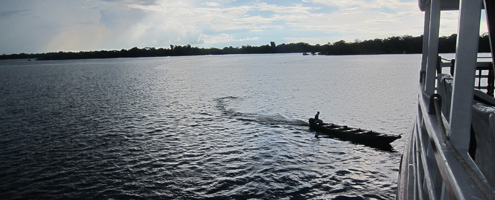 Image courtesy and © Mary Clements 2015 |
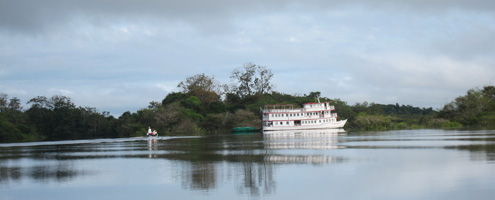 Image courtesy and © Mary Clements 2015 |
But of course the best part of being on M/Y Tucano is getting off and coming home again.
